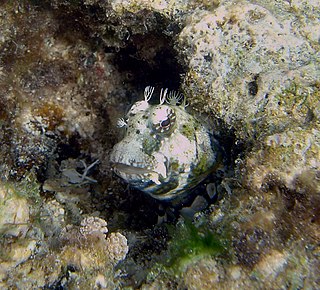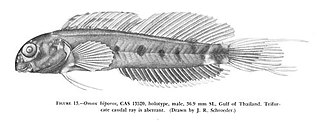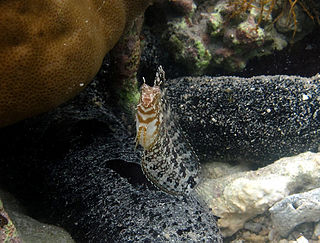
Combtooth blennies are blenniiformids; percomorph marine fish of the family Blenniidae, part of the order Blenniiformes. They are the largest family of blennies with around 401 known species in 58 genera. Combtooth blennies are found in tropical and subtropical waters in the Atlantic, Pacific and Indian Oceans; some species are also found in brackish and even freshwater environments.

Coralliozetus is a genus of chaenopsid blennies mostly found in the eastern Pacific Ocean with one species (C. cardonae) occurring in the western Atlantic Ocean. Additionally, one species (C. clausus) is endemic to Cocos Island, Costa Rica.

Salarias fasciatus, commonly known as the jewelled blenny or lawnmower blenny is a benthic, neritic, marine fish species endemic Australasia. Despite being known as the lawnmower blenny, due to its propensity to consume algae growth from rocks and glass, it is principally a detritivore, with plant material making up only 15% of its diet.. The lawnmower blenny is generally regarded as compatible with most other marine fish species and as a group with other lawnmower blennies. The lawnmower blenny blends in with its surroundings, changing color to hide itself from predators. It stays mostly on the ocean or aquarium floor or on any rock or corals.

Salarias is a genus of combtooth blennies found in the Indian and Pacific oceans.

Atrosalarias fuscus, also known as the dusky blenny, brown coral blenny or black blenny, is a species of marine fish in the family Blenniidae.
Alloblennius is a genus of combtooth blennies found in the western and northeastern Indian Ocean.
Atrosalarias hosokawai is a species of combtooth blenny found in coral reefs in the western Pacific Ocean, from Japan to Papua New Guinea. It can reach a maximum length of 74 millimetres (2.9 in) SL.

Chasmodes is a small genus of combtooth blennies found in the western Atlantic Ocean.
Laiphognathus is a genus of combtooth blennies found in the western Pacific and Indian Oceans.
Lupinoblennius is a genus of combtooth blennies found in the western Atlantic Ocean.

Nannosalarias nativitatis, the pygmy blenny or throatspot blenny, is a species of combtooth blenny found in coral reefs in the western Pacific and Indian oceans. This species grows to a length of 5 centimetres (2.0 in) TL. It is also commonly known as the Christmas blenny or the Christmas Island blenny. This species is the only known member of its genus.
Oman ypsilon, the Oman blenny, is a species of combtooth blenny found in the western Indian ocean, around Oman. This fish reaches a length of 4 centimetres (1.6 in) TL. It is the only known species in the genus Oman.

Omox is a small genus of combtooth blennies found in the western Pacific Ocean.

The ringneck blenny is a species of combtooth blenny widespread in coastal waters of Eastern Atlantic from Spain and Portugal to Möwe Bay, Namibia, in the Mediterranean Sea from Morocco, Algeria, Spain. In the Southwest Atlantic it is found near Brazil and Patagonia, Argentina. Also in Western Indian Ocean from Natal to Knysna in South Africa. This species reaches a length of 12.7 centimetres (5.0 in) SL. It is the type species of the genus Parablennius

Petroscirtes is a genus of combtooth blennies found in the western Pacific, and Indian oceans. Some species of this genus have venom that interacts with opioid receptors. Adults usually inhabit coastal reefs and estuaries to depths of about 10 meters, but they can also be found up to 15 meters in depth in sandy and weedy areas among clumps of Sargassum or other seaweeds in coastal and lagoon reefs. They can be found in nests inside small-necked bottles and abandoned worm tubes or shells.
Rhabdoblennius is a genus of combtooth blennies found in the Pacific Ocean, mostly in the western Pacific. The name of this genus is derived from the Greek word rhabdos meaning "stick" or "rod" and blennius meaning "mucus", referring to the absence of scales on the body of blennies.
Ekemblemaria is a genus of chaenopsid blennies found in the eastern Pacific and western Atlantic oceans.
Emblemariopsis bahamensis, the blackhead blenny, is a species of chaenopsid blenny found in coral reefs in the western Atlantic ocean. It and can reach a maximum length of 2.5 centimetres (0.98 in) TL.
Emblemariopsis bottomei, the Shorthead blenny or the Midnight blenny, is a species of chaenopsid blenny found in coral reefs in the western central Atlantic ocean. It can reach a maximum length of 3 centimetres (1.2 in) SL. The specific name honours Peter Bottome, although who this is, is not specified but it may possibly be the Venezuelan businessman Peter Bottome Deery (1937-2016).

Starksia is a genus of labrisomid blennies native to the western Atlantic Ocean and the eastern Pacific Ocean. Their typical length is 2 cm (0.79 in) SL. The generic name honours the American ichthyologist Edwin Chapin Starks (1867-1932) of Stanford University for his work on Pacific coastal fishes. As a genus Starksia is distinguished from other labrisomids by their scaled bodies, two obvious soft rays in the pelvic fin and the male's have an intromittent organ which is near to or attached to the first spine of their anal fins, which is also somewhat separated from the fin.











